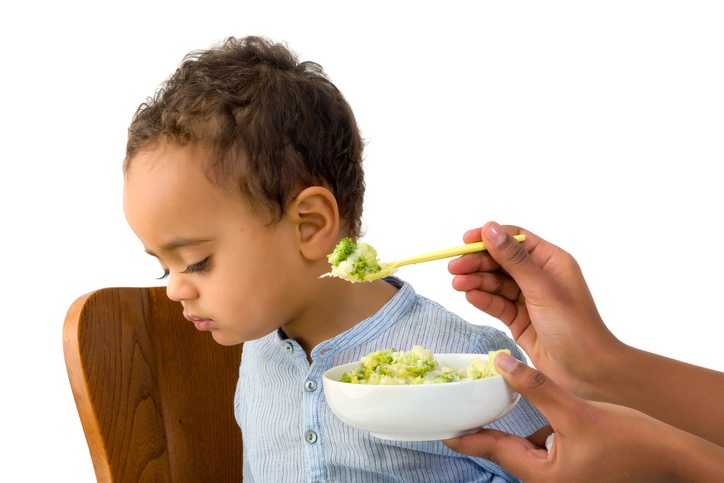A New Mom’s Survival Guide to Life with a Picky Eater
Anyone who has ever been around a small child has likely witnessed a meltdown of sorts surrounding mealtime. Whether it’s refusing to eat anything but chicken nuggets or covering the floor around them in heaps of macaroni and cheese in protest, we can all agree that — at times — kids can be monsters for no reason at all other than to test your patience.
Other times, there’s a reason for it. Maybe they’re teething, need a nap or have an upset tummy. At my home, it’s a combination of food intolerances and flat-out picky eating.
 In fact, to give you an idea of a normal night at our home, picture pure mayhem as a toddler throws food, utensils and cups on the floor at lightening speeds, all while a large dog runs frantically around and under the high chair to collect all edible items before you even have a chance to process what is happening.
In fact, to give you an idea of a normal night at our home, picture pure mayhem as a toddler throws food, utensils and cups on the floor at lightening speeds, all while a large dog runs frantically around and under the high chair to collect all edible items before you even have a chance to process what is happening.
Then, once you think the worst of it is over and said child indicates that they might actually want a bite of the pasta you prepared for them, you hand them the third, non-dog-drool-contaminated fork of the night — because they’re too independent to accept your help — only to repeat the above process all over again.
Every night.
Needless to say, mealtime with young kids can make even the most patient of parents question their existence at times, especially if your kid has been deemed a “picky eater.”
But there is hope. I promise. Or for my sake, that’s what I keep telling myself.
Tips and Tricks
As your pediatrician will likely tell you, most young kids — beginning around the age of 18 months — go through a phase of pickiness when it comes to the food set in front of them. In fact, it’s a great sign of independency because they are learning what their likes and dislikes are. On the other hand, for some it means mentally preparing for battle each night, well past toddlerhood.
If you live with a picky eater, try out some of the tips below:
 Be patient and consistent: It goes without saying, but according to the American Academy of Pediatrics, it can actually take up to 15 times of offering a food before your little one will deem it worthy of consuming. Try serving the food in question in different ways. For example, try steaming, roasting, baking, or mashing sweet potatoes to give them different textures.
Be patient and consistent: It goes without saying, but according to the American Academy of Pediatrics, it can actually take up to 15 times of offering a food before your little one will deem it worthy of consuming. Try serving the food in question in different ways. For example, try steaming, roasting, baking, or mashing sweet potatoes to give them different textures.
- Let them help: Younger toddlers are still learning how to master the use of utensils and want to feed themselves, while older toddlers might be more interested in helping prepare their meals with you. Allowing them to feel independent and involved may trigger more willingness to eat and try new foods. Let your older kids help by letting them shred lettuce with their fingers or sprinkle cheese on their pasta.
- Start small: When introducing new foods, offer appropriately sized portions. Too much food can overwhelm your child, especially when it’s something they’ve never tried before. Remember that a serving size of carrots for you only means a couple of bites to them.
- Don’t force it: There could be multiple reasons why your little one refuses to eat — teething, tiredness, upset tummy — and sometimes they simply just don’t feel like eating, and that’s okay. Let them tell you when they’re hungry or want more of something when they’re ready. According to MayoClinic.org, forcing them to eat might only ignite or reinforce their power struggle over food.
 Get creative: For those who struggle with getting their kids to eat veggies, go stealth mode and try the age-old trick of cooking those items into some of the foods they do like. Add some zucchini to muffins or pureed carrots into spaghetti sauce.
Get creative: For those who struggle with getting their kids to eat veggies, go stealth mode and try the age-old trick of cooking those items into some of the foods they do like. Add some zucchini to muffins or pureed carrots into spaghetti sauce.
- Don’t negotiate or use dessert as a reward: It’s easy to admit to defeat and figure something is better than nothing at all, but negotiating with your kids by saying, “If you take another bite of chicken, you can have a cookie,” could actually make things harder in the long run. By leveraging dessert as a reward, you’re teaching them that dessert is the best type of food, hurting their willingness to try and make healthier choices.
- Offer a variety: While you don’t want to be a short-order chef, try offering at least five different types of foods during a meal. While peas may not be their thing, black beans and brown rice might. Use this as a way to offer new foods alongside their favorites so you can be sure that they eat something.
- Don’t stress if it’s not a balanced meal: There have been times when my son refuses to eat anything other than a banana, and while it drives me insane, it’s better than nothing at all. Remember that some days they’ll eat better than others, but when looking back on the week as a whole, it usually balances out.
 Limit snacks and juice: While snacks are a necessity for growing bodies it’s easy for little bellies to fill up on crackers and juice throughout the day. Try limiting the amount of snacks your child eats in between meals and focus on offering ones that support growth, health and energy. They might be more willing to eat something new at dinnertime because they actually have an appetite.
Limit snacks and juice: While snacks are a necessity for growing bodies it’s easy for little bellies to fill up on crackers and juice throughout the day. Try limiting the amount of snacks your child eats in between meals and focus on offering ones that support growth, health and energy. They might be more willing to eat something new at dinnertime because they actually have an appetite.
- Set a good example: Kids often want to do what you’re doing, whether they’re physically able to or not, so make sure you’re setting healthy examples and eating together as a family.
At the end of the day, just remember that you’re doing your best and that your kid does actually love and appreciate everything you do for them. It’s just one of the joyous moments that make up this journey we call parenthood. Spaghetti-stained walls and all.
Have any other tips and tricks you want to share? Let us know in the comments below!
We’re proud to bring you the freshest content on the web! Follow USANA on Twitter, like our USANA Facebook page and enjoy the latest videos on the official USANA YouTube channel.
 Learn what USANA is doing to make the world a better place.
Learn what USANA is doing to make the world a better place.
The future of personalized health and nutrition is now available with USANA’s True Health Assessment.










Leave a Reply
Want to join the discussion?Feel free to contribute!